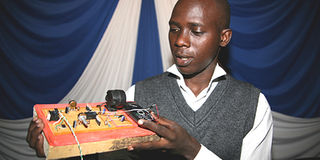Relax! The fish will call the fisherman

Mr Pascal Katana displays his innovation, an electronic fish-luring trap, during the second National Conference on Dissemination of Research Results and Exhibition of Innovations at the KICC on Monday. Photo/HEZRON NJOROGE
What you need to know:
- Student’s invention uses mobile phone technology to alert owner of the catch
The star attraction on the first day of a national scientific conference in Nairobi on Monday was a simple technology that could dramatically change the way small-scale fishermen attract their catch.
Designed by Mr Pascal Katana, a student at the University of Nairobi, the electronic trap lures fish into their captivity by imitating the sound they make when feeding.
“The sound is inaudible to the human ear, but it attracts other fish, and these rush in to share in the bounty,” he told the Nation at Kenyatta International Conference Centre during the start of a five-day National Conference on Dissemination of Research Results and Exhibition of Innovations meeting.
Mr Katana has built a simple, yet sophisticated, trap using discarded radio and computer parts, and his contraption promises to digitalise the way fishermen conduct their business in the country.
“It attracts a school of fish around it, then automatically triggers a signal through an embedded mobile phone to a designated number, alerting the fisherman of the positioning of the fish,” he explains.
“With this technology, one does not need to stay up the whole night waiting for fish. The fish will, instead, call him!”
The conference attracts institutions of higher learning, individuals and other research organisations from across the country.
Both the Kenya Agricultural Research Institute and the Jomo Kenyatta University of Agricultural Technology have gone full throttle on innovation, with the latter presenting what could be the first locally assembled nut-cracking machine.
The cracker, costing about Sh250,000, could be useful to farmers and groups who extract fuel oil from jatropha or castor trees, a trend that is picking pace in the country.
Currently, such groups depend on expensive machines imported from India.
Most of the exhibitors were still rolling out their innovations for display yesterday, while the conference was largely dominated by speeches from government officials.
However, things promise to get more exciting today with the University of Nairobi unveiling a locally developed drug said to have proven successful in curing previously untreatable skin conditions.
The drug, named Wangacid Compound, is also used as a dewormer and for treating abdominal problems, according to Dr Leny Wang’ang’a, who developed it using local materials in collaboration with the University of Nairobi, the National Council for Science and Technology and other institutions.
Dr Wang’an’ga will later in the week be asked to table scientific data to prove the claims.
In the education sector, Strathmore University claims to have found the link between our education system and poor performance at the workplace.
Researchers argue that the exam model used in the country is not adequate to gauge a student’s aptitude, and that a better way of examining both the student’s ability and personality should be introduced.
A model that uses two expert systems to test aptitude will be unveiled during the exhibition.




